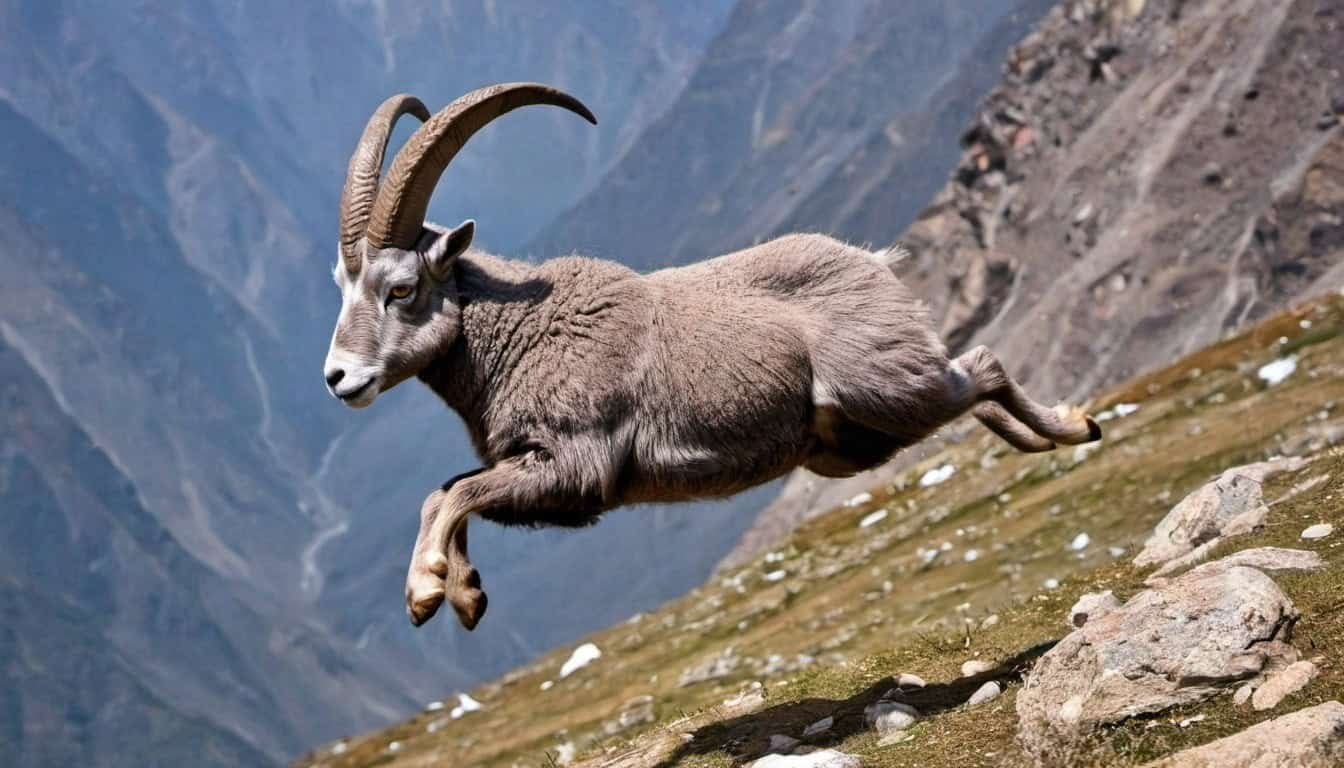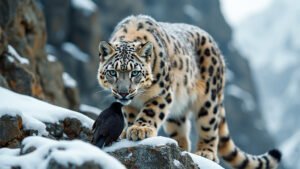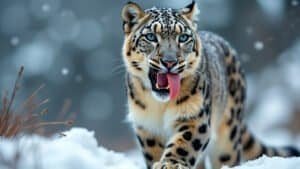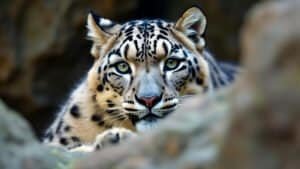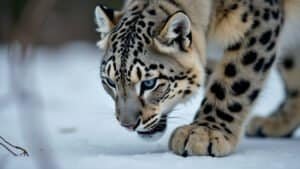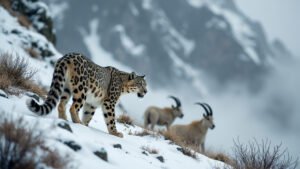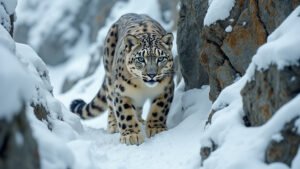Introduction
Snow leopards, the elusive big cats of the mountainous regions of Central and South Asia, have a diet that heavily relies on ungulates. These herbivorous mammals, such as blue sheep and ibex, form a significant part of their prey. Understanding the role of ungulates in the diet of snow leopards is crucial for grasping the dynamics of their survival, hunting strategies, and territorial behaviors
This article will delve into the types of ungulates hunted by snow leopards, the importance of these animals in their diet, the sophisticated hunting techniques employed, and how the availability of these prey affects snow leopard populations and behavior. We will also explore how seasonal changes impact their dietary patterns
Types of Ungulates Hunted by Snow Leopards
Snow leopards predominantly prey on a variety of ungulates that inhabit their rugged, high-altitude environments
These prey species are crucial for the snow leopards’ survival, providing the necessary nutrition and energy to thrive in harsh conditions. Understanding which ungulates are most commonly hunted by snow leopards helps conservationists better manage and protect both predator and prey populations
Common Prey Species
Snow leopards primarily hunt blue sheep (also known as bharal), Siberian ibex, and argali sheep. Blue sheep are particularly important in the diet of snow leopards in the Himalayas and Tibetan Plateau
These sheep are well-adapted to steep, rocky terrain, making them a challenging yet rewarding prey. Siberian ibex are another key species, found in various regions such as Mongolia, Russia, and parts of China. The large and powerful argali sheep are less frequently hunted but still represent a significant source of food due to their size
Regional Differences in Prey
The types of ungulates hunted by snow leopards can vary significantly depending on the region. For instance, in the Himalayas, blue sheep are more prevalent, whereas in the Altai Mountains, Siberian ibex dominate the snow leopard’s diet
In regions like the Tien Shan Mountains, a combination of blue sheep and ibex can be found, leading to a more diverse prey base. This regional variation is essential for understanding the adaptability of snow leopards to different environments and the availability of prey
Rarity and Abundance of Ungulates
The abundance of ungulate populations directly impacts snow leopard hunting success and diet. In areas where prey is abundant, snow leopards can hunt more frequently and successfully
However, in regions where ungulates are scarce due to overhunting by humans or habitat loss, snow leopards may struggle to find enough food, leading to potential declines in their population. Conservation efforts often focus on maintaining healthy populations of these ungulates to ensure the survival of snow leopards
Common Prey Species: Detailed Analysis
Blue Sheep (Bharal): Found primarily in the Himalayas and Tibetan Plateau, blue sheep are a primary food source for snow leopards
These medium-sized ungulates are adapted to rocky, steep terrains, which align with the snow leopard’s habitat. Blue sheep live in herds, and their agile movements on cliffs and ridges provide a challenging hunt for the snow leopards, testing their stalking and ambush techniques
Siberian Ibex: These are found in the mountainous regions of Russia, Mongolia, and China. Siberian ibexes are large, robust ungulates with impressive climbing abilities, often found on precipitous slopes
Their presence in these areas makes them a vital part of the snow leopard’s diet, especially where blue sheep are less common
Argali Sheep: The largest wild sheep species, argali are hunted less frequently due to their size and strength but provide a substantial meal when successfully taken down
Argali sheep inhabit various mountain ranges across Central Asia, including the Altai and Tien Shan Mountains. Their size means that a successful hunt can sustain a snow leopard for a longer period
Regional Differences in Prey: In-Depth Look
Himalayan Region: The high altitudes and rugged landscapes of the Himalayas are home to blue sheep, which form the cornerstone of the snow leopard diet in this region. This area also sees snow leopards occasionally preying on Himalayan tahr, a less common but still significant part of their diet
Altai Mountains: In the Altai range, the Siberian ibex is the predominant prey. This region’s harsh winters and rocky terrain make the ibex an essential resource for snow leopards, which have adapted their hunting strategies to catch these agile and elusive animals
Tien Shan Mountains: This mountain range presents a more diverse prey base, including both blue sheep and ibex. The availability of multiple prey species supports a healthy snow leopard population, demonstrating the adaptability of these predators to different ecological conditions
Rarity and Abundance of Ungulates: Conservation Insights
The presence of healthy ungulate populations is critical for snow leopard conservation. Overhunting, habitat degradation, and competition with livestock can significantly reduce ungulate numbers, directly affecting snow leopard survival
Conservation programs often focus on protecting ungulate habitats, regulating hunting practices, and working with local communities to minimize human-wildlife conflicts
In regions where ungulates are abundant, snow leopards thrive, maintaining stable population levels and exhibiting natural hunting behaviors
Conversely, in areas with depleted prey bases, snow leopards may resort to preying on livestock, leading to increased human-wildlife conflict and retaliatory killings. Ensuring a balanced ecosystem with ample prey is essential for the long-term survival of snow leopards
Importance of Ungulates in Snow Leopard Diet
Ungulates play a crucial role in the diet of snow leopards, providing the primary source of nutrition and energy for these elusive predators. The availability and abundance of these prey species directly impact the health, behavior, and population dynamics of snow leopards across their range
Nutritional Value
Ungulates offer a rich source of protein and fat, which are essential for the survival and health of snow leopards. A single kill can provide substantial nourishment, allowing the snow leopard to sustain itself for several days
This is especially important in the harsh and resource-scarce environments where snow leopards live. The high protein content helps in muscle maintenance and growth, while the fat is crucial for energy, particularly in the cold mountainous regions where these predators reside
Percentage of Diet
Studies have shown that ungulates make up a significant portion of the snow leopard’s diet. Research conducted by the Snow Leopard Trust indicates that in certain regions, ungulates account for up to 70% of the diet
For instance, in the Indian Himalayas, blue sheep constitute a major part of the prey base. In Mongolia, Siberian ibex is a common prey item. This reliance on large herbivores underscores their importance in maintaining the energy balance and overall health of snow leopard populations
Comparison with Other Prey
While ungulates are the primary prey, snow leopards do exhibit dietary flexibility and will hunt smaller mammals, birds, and even scavenge when necessary. Smaller prey, such as marmots, hares, and game birds, are often targeted during periods when ungulates are less accessible
However, these smaller animals do not provide the same caloric intake as ungulates, making them a less significant part of the diet. This adaptability is crucial for survival, but the nutritional value and sustenance provided by ungulates are unparalleled
Nutritional Value: Detailed Analysis
Protein Content: The high protein content in ungulate meat is vital for snow leopards
Protein aids in the maintenance of muscle mass, crucial for the physical demands of hunting and surviving in rugged terrains. It also supports reproductive health and the growth of young cubs, ensuring the species’ continuation
Fat Reserves: The fat found in ungulates is a critical energy source, especially during the harsh winter months. Fat reserves help snow leopards maintain their body temperature and provide energy during periods when hunting is challenging due to deep snow and severe weather conditions
Essential Nutrients: In addition to protein and fat, ungulate meat provides essential vitamins and minerals that contribute to the overall health of snow leopards
These nutrients support various bodily functions, from bone health to immune system efficiency, ensuring that snow leopards remain resilient against diseases and injuries
Percentage of Diet: Research Findings
Himalayan Blue Sheep: In the Indian and Nepalese Himalayas, blue sheep are the dominant prey, constituting up to 60-70% of the snow leopard’s diet. This high dependency highlights the critical role of this species in the local ecosystem and the survival of snow leopards in these regions
Siberian Ibex in Mongolia: In the rocky steppes of Mongolia, Siberian ibex form a substantial part of the diet, often making up around 50-60%. The availability of these ibex directly correlates with the health and stability of the snow leopard population in these areas
Argali Sheep Contributions: Although less frequent in the diet due to their larger size and difficulty to hunt, argali sheep provide a significant nutritional boost when captured. In some Central Asian regions, they account for about 20-30% of the diet during specific seasons
Comparison with Other Prey: Adaptive Strategies
Smaller Mammals and Birds: During the summer months or in areas where ungulates are less abundant, snow leopards diversify their diet to include smaller mammals like marmots and pikas, as well as birds. While these prey items supplement their diet, they do not provide the same caloric intake as ungulates
Scavenging: In times of scarcity, snow leopards are known to scavenge on carrion. This opportunistic behavior helps them survive during lean periods but is not a primary food source. Scavenging can also expose them to risks such as conflicts with other predators and potential human encounters
Livestock Predation: In regions where natural prey is scarce, snow leopards may turn to livestock, leading to conflicts with local herders. This behavior is typically a last resort and underscores the importance of maintaining healthy ungulate populations to reduce human-wildlife conflicts
Hunting Strategies of Snow Leopards
Snow leopards are skilled predators, employing a variety of sophisticated hunting strategies to capture their ungulate prey in the challenging terrains they inhabit
Their success as hunters is due to a combination of physical adaptations, stealth, and learned behaviors passed down through generations
Stalking Techniques
Snow leopards rely heavily on their ability to blend into their environment, thanks to their camouflage fur that mimics the rocky and snowy landscapes they traverse. Stalking is a crucial part of their hunting strategy, where they silently approach their prey until they are within striking distance:
Camouflage and Stealth: The snow leopard’s fur pattern provides excellent camouflage, allowing it to remain undetected while stalking prey. They often use the cover of rocks, bushes, and other natural features to get as close as possible to their target without being seen
Silent Movement: Snow leopards are known for their quiet and calculated movements. Their large, padded paws help muffle their footsteps, enabling them to move silently across snow and rocky ground. This stealthy approach is vital for closing the distance to their prey before launching an attack
Patient Observation: Snow leopards spend significant time observing their prey from a distance. This patience allows them to understand the movements and behaviors of their targets, choosing the optimal moment to initiate the hunt
Ambush Methods
Ambush hunting is a common strategy employed by snow leopards, taking advantage of their surroundings to surprise their prey. This method requires the predator to be both strategic and opportunistic:
Choosing Ambush Sites: Snow leopards often select specific locations where they have a strategic advantage, such as ledges, cliffs, or ridges. These sites provide a higher vantage point and allow the snow leopard to pounce on unsuspecting prey from above
Timing the Attack: Timing is crucial in an ambush. Snow leopards wait for their prey to be in a vulnerable position, such as grazing or drinking water, before making their move. The element of surprise increases the chances of a successful kill
Rapid Acceleration: Once the ambush is initiated, snow leopards can accelerate rapidly, using their powerful hind legs to leap significant distances. This sudden burst of speed and power is often enough to overwhelm their prey, leading to a successful capture
Use of Terrain
The rugged and often treacherous terrain of snow leopard habitats plays a significant role in their hunting strategies. These big cats are adept at navigating steep slopes, rocky outcrops, and deep snow, using the landscape to their advantage:
Navigating Steep Slopes: Snow leopards are incredibly agile, capable of traversing steep and uneven terrain with ease. Their strong limbs and flexible spine allow them to make quick, agile movements, essential for pursuing prey in such environments
Leaping Across Gaps: Snow leopards can leap up to 50 feet in a single bound, allowing them to cross large gaps between rocks and cliffs. This ability not only aids in hunting but also in evading potential threats
Snow and Ice: In snowy environments, snow leopards utilize their broad paws to walk on snow without sinking. This adaptation is particularly useful for stalking prey in winter conditions when other animals might struggle to move quietly and efficiently
Stalking Techniques: Detailed Breakdown
Camouflage Mastery: The snow leopard’s coat, with its rosettes and pale color, blends seamlessly with the rocky and snowy environment. This natural disguise is crucial for stalking prey without being detected
Precision in Movement: Their methodical and silent movements, combined with keen eyesight and hearing, allow snow leopards to approach their prey closely. They often freeze mid-step if the prey shows any signs of awareness, resuming only when the target relaxes
Environmental Awareness: Snow leopards are highly attuned to their environment. They use natural features like wind direction to avoid alerting prey with their scent and prefer to hunt during dawn or dusk when their camouflage is most effective
Ambush Methods: In-Depth Analysis
Strategic Positioning: By choosing ambush sites that provide cover and elevation, snow leopards maximize their chances of a successful hunt. Elevated positions allow them to launch powerful and surprise attacks from above, minimizing the risk of a prolonged chase
Patient Timing: Snow leopards exhibit remarkable patience, sometimes waiting hours for the right moment to strike. This patience ensures that they expend energy only when there is a high probability of a successful kill
Attack Efficiency: The initial leap and powerful swipes are designed to incapacitate prey quickly. Snow leopards aim to deliver a fatal bite to the neck or throat, ensuring a swift and efficient kill
Use of Terrain: Tactical Advantages
Agility on Slopes: Snow leopards’ muscular build and flexible joints enable them to maneuver steep and rocky terrains with ease. This agility is crucial for chasing and cornering prey that attempts to escape uphill
Mastery of Gaps and Cliffs: Their ability to leap vast distances is a significant advantage in the mountainous regions they inhabit. This skill allows snow leopards to navigate the terrain more effectively than their prey, giving them a tactical edge during hunts
Adaptation to Snow: The physical adaptations of snow leopards, such as their wide, fur-covered paws, enable them to walk on snow without sinking. This adaptation is particularly advantageous when stalking prey in snowy conditions, as it allows for silent and efficient movement
Impact of Ungulate Availability on Snow Leopards
The availability of ungulates directly influences the health, behavior, and population dynamics of snow leopards. As their primary prey, the abundance or scarcity of ungulates can significantly affect snow leopards’ survival and reproductive success
Population Health
The health of snow leopard populations is closely tied to the availability of ungulate prey. Adequate prey ensures that snow leopards receive the necessary nutrients to maintain their physical health, support reproduction, and rear cubs:
Nutritional Adequacy: When ungulates are plentiful, snow leopards can hunt more efficiently, securing the high-calorie diet they need. This nutritional adequacy leads to better overall health, stronger immune systems, and higher cub survival rates
Breeding Success: Well-nourished snow leopards are more likely to reproduce successfully. Females with access to ample prey have higher energy reserves, which support pregnancy and lactation, leading to healthier and more viable offspring
Cub Rearing: Adequate prey availability allows mother snow leopards to provide sufficient food for their cubs. This consistent food supply is critical for the growth and development of young leopards, ensuring they reach maturity and can fend for themselves
Breeding Success
Snow leopards’ reproductive success is closely linked to the abundance of ungulates. Sufficient prey supports the demanding energy needs of breeding and raising cubs:
Mating Opportunities: In areas with abundant prey, snow leopards are less stressed and more likely to engage in mating behaviors. This leads to higher chances of successful copulation and conception
Pregnancy and Lactation: Adequate nutrition during pregnancy ensures that females can sustain the energy requirements of gestation. Post-birth, lactating mothers need high-calorie diets to produce enough milk for their cubs
Cub Mortality Rates: When prey is scarce, cub mortality rates increase. In contrast, regions with plentiful ungulates see higher cub survival rates, contributing to population stability and growth
Migration Patterns
The availability of ungulates can also influence the movement and territorial behavior of snow leopards. In search of prey, snow leopards may adjust their home ranges and migrate to areas with higher ungulate densities:
Territorial Range: In regions with abundant prey, snow leopards can maintain smaller, more stable territories. This reduces the energy expended in searching for food and allows more efficient hunting
Seasonal Movements: Snow leopards may exhibit seasonal migrations following the movement patterns of their prey. For instance, they might descend to lower altitudes during winter when ungulates migrate to avoid deep snow
Dispersal of Young: Young snow leopards, upon reaching maturity, may disperse over longer distances in search of territories with adequate prey. This dispersal is crucial for genetic diversity and the establishment of new populations
Population Health: Detailed Analysis
Immune System Support: A diet rich in ungulates provides essential vitamins and minerals that bolster the immune system of snow leopards. This enhanced immunity helps protect against diseases and infections, which is vital for survival in harsh environments
Physical Fitness: Regular access to prey ensures that snow leopards remain physically fit. The muscle mass and energy reserves built from a steady diet of ungulates are crucial for enduring the physical demands of hunting and surviving extreme weather conditions
Longevity: Healthy, well-fed snow leopards tend to live longer, which contributes to a stable and thriving population. Longevity also means more breeding opportunities, further supporting population growth
Breeding Success: In-Depth Look
Energy Reserves for Reproduction: Successful reproduction requires significant energy. Females need ample reserves to support the energetic costs of pregnancy, birth, and lactation. Without sufficient prey, the energy deficit can lead to failed pregnancies or weak cubs
Cub Growth and Development: Cubs require a nutrient-rich diet for proper growth. In areas with abundant ungulates, cubs are more likely to receive regular and adequate nourishment, leading to better health and higher chances of survival
Population Dynamics: Higher cub survival rates contribute to a balanced population structure, with a healthy mix of juveniles, sub-adults, and adults. This balance is crucial for the long-term sustainability of snow leopard populations
Migration Patterns: Tactical Movements
Adaptive Territoriality: Snow leopards demonstrate remarkable adaptability in their territorial behavior. In response to prey availability, they may expand or contract their home ranges, optimizing their hunting efficiency and resource use
Following Prey Movements: Seasonal migrations of ungulates often dictate the movement patterns of snow leopards. By following prey, snow leopards ensure continuous access to food, which is especially critical during harsh winter months when prey is less accessible
Establishing New Territories: Young adults seeking their own territories may migrate considerable distances to find areas with sufficient prey. This dispersal not only prevents inbreeding but also helps establish new populations, contributing to species resilience
Seasonal Variations in Diet
Snow leopards exhibit significant seasonal variations in their diet, driven by changes in prey availability and environmental conditions. Understanding these seasonal patterns is essential for comprehending the adaptive strategies snow leopards use to survive in their harsh habitats
Winter vs. Summer Prey
During the winter months, snow leopards often face more challenging hunting conditions due to deep snow and harsher weather. These conditions influence the types of prey they hunt and their hunting strategies:
Winter Prey: In winter, snow leopards primarily target larger ungulates such as blue sheep and ibex, which provide substantial sustenance to endure the cold months. These ungulates tend to move to lower altitudes where vegetation is still accessible, making them more available to snow leopards
Summer Prey: During the summer, the snow leopards’ diet becomes more diverse. They continue to hunt ungulates but also include smaller mammals like marmots, hares, and birds. The warmer weather and increased prey availability at higher altitudes allow for a more varied diet
Nutritional Needs: The caloric needs of snow leopards increase in winter due to the need to maintain body heat. Therefore, they rely more heavily on high-fat and high-protein prey such as ungulates during this season
Impact of Snowfall
Snowfall can significantly affect the hunting success and dietary habits of snow leopards. Heavy snowfall can hinder the movement of both predator and prey, leading to changes in hunting strategies and prey selection:
Hunting Efficiency: Deep snow can impede the movement of snow leopards, making stalking and ambushing more difficult. As a result, they may adapt by hunting in areas with less snow or targeting prey that is easier to catch in such conditions
Prey Availability: Snowfall can also affect the availability of prey. Some ungulates may move to lower elevations to escape deep snow, concentrating their populations and making them more accessible to snow leopards. Conversely, smaller mammals that burrow or seek shelter may become harder to locate
Energy Expenditure: Hunting in deep snow requires more energy, which can impact the overall health and condition of snow leopards. Successful hunts during this period are critical for maintaining energy reserves
Adaptive Behaviors
Snow leopards exhibit various adaptive behaviors to cope with seasonal changes in prey availability and environmental conditions. These adaptations help ensure their survival throughout the year:
Territory Shifts: Snow leopards may adjust their home ranges seasonally to follow prey migrations. They often move to lower altitudes in winter and return to higher elevations in summer, aligning with the movement patterns of their prey
Dietary Flexibility: Snow leopards demonstrate remarkable dietary flexibility, shifting their prey preferences based on availability. This adaptability is key to their survival in environments where prey populations can fluctuate widely with the seasons
Behavioral Adjustments: Snow leopards may change their hunting times and techniques based on the season. For example, they might hunt more actively during daylight hours in winter when prey is more visible against the snow, whereas in summer, they might prefer dawn and dusk when temperatures are cooler
Winter vs. Summer Prey: Detailed Analysis
Winter Prey: The focus on larger ungulates during winter is a strategic choice, as these animals provide the necessary calories to sustain snow leopards through the colder months. Hunting larger prey reduces the frequency of hunts required, conserving energy in harsh conditions
Summer Prey: In summer, the diet diversification to include smaller mammals and birds helps snow leopards take advantage of the increased prey abundance. This period allows snow leopards to build up energy reserves and recover from the harsh winter months
Prey Movement Patterns: Understanding the seasonal movement patterns of prey species like blue sheep and ibex is crucial for snow leopards. These ungulates often migrate to find food, and snow leopards follow, ensuring continuous access to prey
Impact of Snowfall: In-Depth Look
Hunting Challenges: Deep snow can make it difficult for snow leopards to move stealthily and efficiently. They often adjust by using ridges and rock outcrops for better vantage points and easier movement
Prey Vulnerability: Ungulates struggling in deep snow become easier targets, but snow leopards must balance the energy cost of hunting in such conditions. Successful hunts during heavy snowfall periods are vital for their survival
Snow Density and Behavior: The density and consistency of snow can affect hunting success. Soft, deep snow impedes movement more than compacted snow. Snow leopards may time their hunts to periods when snow is firmer, such as early mornings after cold nights
Adaptive Behaviors: Survival Strategies
Seasonal Migration: By following the seasonal migrations of prey, snow leopards ensure a consistent food supply. This migration often involves moving between different altitudes and terrains, demonstrating their adaptability
Dietary Shifts: In lean periods, snow leopards may resort to scavenging or hunting smaller, less energy-dense prey. This dietary flexibility helps them survive when preferred prey is scarce
Behavioral Flexibility: Snow leopards are known to adjust their activity patterns based on prey behavior and environmental conditions. They may become more nocturnal in regions with human activity to avoid encounters and increase hunting success
Conclusion
Ungulates play a critical role in the diet of snow leopards, providing the essential nutrition required for their survival in some of the world’s most challenging environments
Snow leopards primarily hunt ungulates such as blue sheep, Siberian ibex, and argali sheep, which constitute a significant portion of their diet. These prey species offer high protein and fat content, crucial for maintaining the snow leopards’ physical health and energy levels
The availability of ungulates impacts snow leopard population health, breeding success, and migration patterns. Adequate prey ensures nutritional adequacy, supports reproductive success, and reduces cub mortality rates. Snow leopards exhibit a range of sophisticated hunting strategies, including stalking, ambushing, and leveraging their rugged terrain, to effectively capture their prey
Seasonal variations also influence the diet and behavior of snow leopards. During winter, they rely more on large ungulates, while in summer, their diet becomes more diverse with the inclusion of smaller mammals and birds. Understanding these dietary patterns and adaptive behaviors is essential for effective conservation efforts
By protecting and managing ungulate populations, conservationists can help ensure the continued survival of snow leopards. Maintaining balanced ecosystems and reducing human-wildlife conflicts are vital for preserving these majestic predators and their natural habitats
